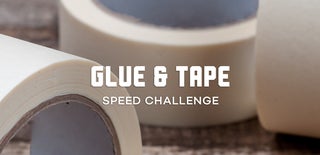Introduction: Small Wooden Guns (using Ample Adhesive)
Do you need to have small cheap and easy to make wooden guns? Probably not, but you may want to make some all the same.
In this instructable I will share the thought process and techniques I use to glue together small pieces of wood to make realistic looking scale guns.
(You don't need to make guns they are just the example I'm making - the thought processes and techniques can be applied to crafting other items).
Supplies
You will need:
- File/sanding block/sanding paper
- Craft knife/scalpel
- Super glue. (I use Loctite Power Flex as it is more viscous and less fluid than normal super glue)
- Cocktail sticks/Kebab skewers and other bits-and-bobs. (I recommend multiple different shapes and sizes)
- Any other random piece of anything: foil, dressmaking pins et cetera...
Step 1: How to Visualise the Concept:
First you need to decide on the gun you are going to model - which sort of explains itself.
Next you need to visualise how you could split up the gun into separate components and how they could go together. For example, with the AK-47 that I made the front segment so that it is split into four around the barrel to get the correct contours.
I recommend looking at colour splits in the gun as they are often good places to break it up.
Step 2: How to Make the Wooden Pieces:
I tend to make the segments one after the other and stick them on in the same consecutive way (unless you need symmetrical pieces).
I like to begin by carving off bits with a craft knife to make a general outline and then sanding it smooth.
For magazines and some handles I split the kebab skewer in half to make it thinner than than the main gun body and add interest to the gun.
Step 3: How to Attach the Pieces:
Once I have the pieces I tend to use a thick cyanoacrylate so that it dries fast and has plenty of surface tension and doesn't disperse too much. I like to rest the pieces on top of some grease proof paper once they have been held for a bit as if some glue manages to drip over the join it won't remain stuck too securely to the paper.
I recommend sanding the edges of the pieces flat so that the glue has a stronger surface to bond on especially if your glue isn't that thick.
Step 4: Finishing Touches:
You should now have an almost finished wooden gun but you may want to enhance it with features that you couldn't make with the wooden pieces.
I have used many different things to improve the wooden guns including a penny (British) which I sanded completely flat on both sides to use as a magazine, a strip of copper foil (but any type of foil should work) and dressmaking pins snapped off at various lengths.
The beauty of cyanoacrylate is that it will cause most things to adhere to one another.

Participated in the
Glue & Tape Speed Challenge











